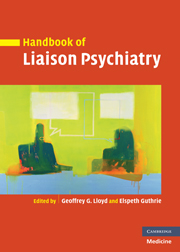Book contents
- Frontmatter
- Contents
- List of contributors
- Preface
- Part I Basic skills
- Part II Common psychiatric problems across the general hospital
- Part III Working with specific units
- 14 Neurological disorders
- 15 Cardiorespiratory disorders
- 16 Gastrointestinal disorders
- 17 Liver disorders
- 18 Endocrine disorders
- 19 Diabetes
- 20 HIV and AIDS
- 21 Renal disease
- 22 Musculo-skeletal disorders
- 23 Oncology
- 24 Head and neck cancer
- 25 Palliative care
- 26 Cosmetic procedures
- 27 Perinatal and gynaecological disorders
- 28 The intensive care unit
- 29 The burns unit
- 30 Psychocutaneous disorders
- 31 Genitourinary disorders
- 32 The emergency department
- Part IV Treatment
- Part V Different treatment settings
- Index
- References
16 - Gastrointestinal disorders
from Part III - Working with specific units
Published online by Cambridge University Press: 10 December 2009
- Frontmatter
- Contents
- List of contributors
- Preface
- Part I Basic skills
- Part II Common psychiatric problems across the general hospital
- Part III Working with specific units
- 14 Neurological disorders
- 15 Cardiorespiratory disorders
- 16 Gastrointestinal disorders
- 17 Liver disorders
- 18 Endocrine disorders
- 19 Diabetes
- 20 HIV and AIDS
- 21 Renal disease
- 22 Musculo-skeletal disorders
- 23 Oncology
- 24 Head and neck cancer
- 25 Palliative care
- 26 Cosmetic procedures
- 27 Perinatal and gynaecological disorders
- 28 The intensive care unit
- 29 The burns unit
- 30 Psychocutaneous disorders
- 31 Genitourinary disorders
- 32 The emergency department
- Part IV Treatment
- Part V Different treatment settings
- Index
- References
Summary
Introduction
This chapter covers psychological issues and psychiatric morbidity in relation to diseases and conditions associated with the gastrointestinal (GI) tract. Both organic and so-called functional gastrointestinal disease states are considered. Chapter 17 covers psychiatric conditions associated with diseases of the liver.
Peptic ulcer disease
The term peptic ulcer refers to both gastric and duodenal ulcers. The epidemiology of peptic ulcer disease has changed dramatically over the last 20 years. Duodenal ulcer used to be 10 times as common in men as women and gastric ulcer had a male preponderance of 3:2. Now the difference in frequency between men and women is much less, largely because of Helicobacter pylori eradication. The annual age-standardized period prevalence of peptic ulceration in the UK decreased from 3.3 per 1000 in 1994 to 1.5 per 1000 in 1998 for men, and from 1.8 per 1000 to 0.9 per 1000 for women (Kang et al. 2002). Current trends are for a decreasing incidence in young men, with a rise in older women.
Important aetiological factors include H. pylori, non-steroidal anti-inflammatory drugs (NSAIDs), acid and pepsin. Other important factors include smoking, alcohol, bile acids, aspirin, steroids and stress.
The symptoms of peptic ulceration are very non-specific and diagnosis is unreliable on history alone. In uncomplicated cases there is often very little to find on examination. Treatment involves lifestyle changes including cessation of smoking and withdrawal of medication which may have caused the ulceration.
Keywords
- Type
- Chapter
- Information
- Handbook of Liaison Psychiatry , pp. 390 - 415Publisher: Cambridge University PressPrint publication year: 2007

